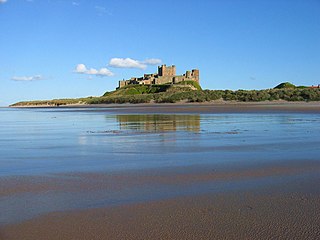See also
Name list
This page or section lists people that share the same given name. If an internal link led you here, you may wish to change that link to point directly to the intended article.
Eadwulf (sometimes Eadulf) is an Anglo-Saxon male name. Notable people with the name include:
Eadwulf I was ruler of Bamburgh in the early tenth century. A genealogy in the twelfth-century text De Northumbria post Britannos recording the ancestry of Waltheof Earl of Northampton, makes Eadwulf the son of Æthelthryth daughter of Ælla, King of Northumbria, but no source names Eadwulf's own father.
Ealdred was a ruler of Bamburgh, at least part of the former kingdom of Bernicia in northern Northumbria, in the early tenth century. He was the son of Eadwulf.
Eadulf IV or Eadwulf IV was the ruler of Bamburgh from 1038 until his death. He was a son of Uhtred the Bold and his second wife Sige, daughter of Styr Ulfsson. Eadwulf had one full sibling, a younger brother Gospatric. He succeeded his older half-brother Ealdred, who was murdered by the son of Thurbrand the Hold in a bloodfeud started when Thurbrand murdered Uhtred. The Anglo-Saxon Chronicle asserts that in 1041 Eadwulf was "betrayed" by King Harthacnut. The "betrayal" seems to have been carried out by Siward, Earl of Northumbria; when the Libellus de exordio and other sources write about the same event, they say that Siward attacked and killed Eadulf. Siward then became earl of all Northumbria, perhaps the first person to do so since Uhtred the Bold. Eadulf was the last of the ancient Bernician line of earls to rule until his son Osulf usurped the Northumbrian earldom in 1067.
Uhtred of Bamburgh, was ruler of Bamburgh and from 1006 to 1016 the ealdorman of Northumbria. He was the son of Waltheof I, ruler of Bamburgh (Bebbanburg), whose family the Eadwulfingas had ruled the surrounding region for over a century. Uhtred's death by assassination was described in De obsessione Dunelmi and has been interpreted as the beginning of a blood feud. Lest he be confused with Uhtred, the son of Eadwulf I of Bamburgh, he historically has been referred to as Uhtred the Bold.

Oswulf was ruler of Bamburgh and subsequently, according to later tradition, commander of all Northumbria under the lordship of King Eadred of England. He is sometimes called "earl" or "high reeve", though the precise title of the rulers of Bamburgh is unclear. By the twelfth century Oswulf was held responsible for the death of Northumbria's last Norse king, Eric of York, subsequently administering the Kingdom of York on behalf of Eadred.
Waltheof was high-reeve or ealdorman of Bamburgh. He was the son of Ealdred, and the grandson of Oswulf I and was father of Uhtred the Bold, Ealdorman of Northumbria.
Eadwulf I was king of Northumbria from the death of Aldfrith in December 704 until February or March of 705, when Aldfrith's son Osred was restored to the throne.

The Battle of Carham was fought between the English ruler of Bamburgh and the king of Scotland in alliance with the Cumbrians. The encounter took place in the 1010s, most likely 1018, at Carham on Tweed in what is now Northumberland, England. Uhtred, son of Waltheof of Bamburgh, fought the combined forces of Malcolm II of Scotland and Owen the Bald, king of the Cumbrians. The result of the battle was a victory for the Scots and Cumbrians.
Ælfric is an Anglo-Saxon given name, consisting of the elements ælf, "elf" and ric, "a powerful person, ruler".
Eadwulf Cudel or Cutel, sometimes numbered Eadwulf III, was ruler of Bamburgh for some period in the early eleventh century. Following the successful takeover of York by the Vikings in 866/7, southern Northumbria became part of the Danelaw, but in the north English rulers held on from a base at Bamburgh. They were variously described as kings, earls, princes or high-reeves, and their independence from the kings of England and Scotland is uncertain. Uhtred the Bold and Eadwulf Cudel were sons of Waltheof, ruler of Bamburgh, who died in 1006. He was succeeded by Uhtred, who was appointed by Æthelred the Unready as earl in York, with responsibility for the whole of Northumbria. Uhtred was murdered in 1016, and king Cnut then appointed Erik, son of Hakon, earl at York, while Eadwulf succeeded at Bamburgh.
Ælfwald may refer to:
Events from the 1040s in England.
Events from the 10th century in the Kingdom of England.
Eadulf or Eadwulf Rus was an 11th-century Northumbrian noble. He was either the son or grandson of Gospatric, possibly the man who soon after Christmas 1064 was allegedly killed on behalf of Tostig, Earl of Northumbria. This murder by Tostig led to a great northern revolt against Edward the Confessor, a revolt that turned both King Edward and Harold Godwinson against Tostig and led to the appointment of the Mercian, Morcar, as Earl of northern England.
Eadwulf of Northumbria may refer to:

The Rulers of Bamburgh were significant regional potentates in what is now northern England and south-eastern Scotland during the Viking Age. Sometimes referred to in modern sources as the Earldom of Bamburgh, their polity existed for roughly two centuries, beginning after the attacks on the Anglo-Saxon Kingdom of Northumbria by the Vikings in the later ninth century, and ending after the Norman Conquest later in the eleventh century. In Scottish and Irish sources of the period the Bamburgh 'earldom' is referred to as the kingship of the Northern English, or simply of the 'Saxons'.
Eadwulf II or Eadulf II may refer to:
Eadwulf II, nicknamed Evil-child, was ruler of Bamburgh in the latter half of the tenth century. Although Eadwulf is sometimes described as the Earl of Northumbria, he ruled only a northern portion of Northumbria, a polity centred on Bamburgh that once stretched from the Firth of Forth to the River Tees.
Eadwulf of Bamburgh or Eadwulf of Bernicia may refer to:
Eadwulf I may refer to: